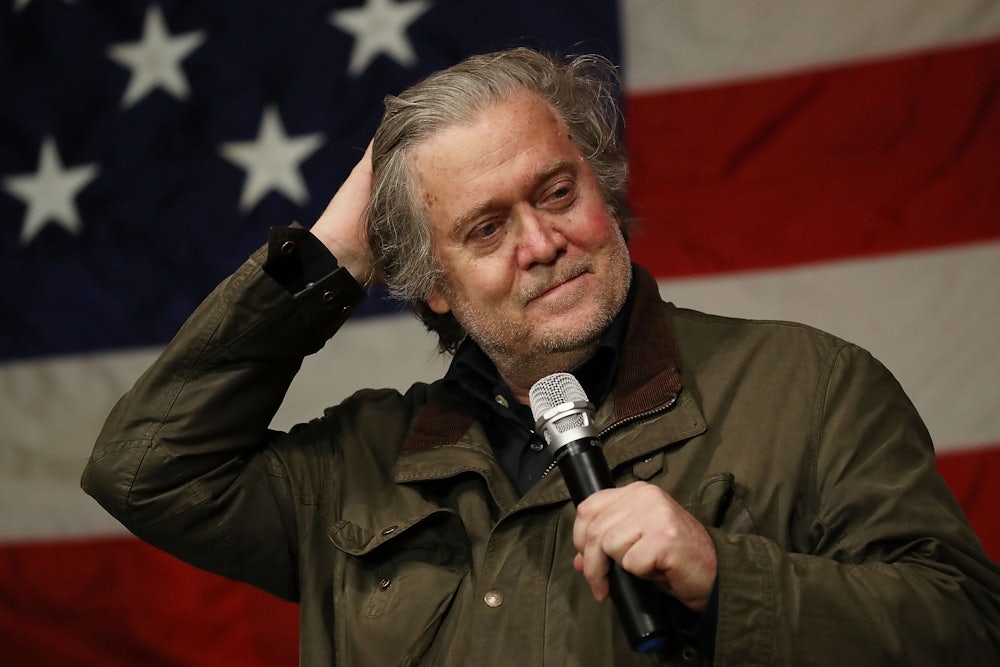Few political figures have fallen from grace as quickly and as completely as Steve Bannon. Less than a year ago, Time magazine was asking, “Is Steve Bannon the Second Most Powerful Man in the World?” Then the President Donald Trump’s chief strategist, Bannon was widely credited as the mastermind behind the populist right-wing campaign that won Trump the White House. He was supposedly going to remake the Republican Party by sidelining establishment figures like House Speaker Paul Ryan and Senate Majority leader Mitch McConnell and getting the GOP to accept trade protectionism, immigration restriction, and major infrastructure spending, and to reject neoconservative foreign policy hubris.
But Bannon quickly lost clout in the White House, often outwitted by both the Republican establishment and the president’s son-in-law, Jared Kushner. In August, he was fired from the White House, and returned to his former job as CEO of the right-wing Breitbart News. This was followed by another defeat, in December, when the insurgent Republican candidate he backed in the Alabama Senate race, Roy Moore, lost in an upset to Democrat Doug Jones. Stripped of his White House post, and his reputation as a political guru in tatters, Bannon still had his ample media megaphone. But on Tuesday, he lost that as well when he was forced to resign, a move apparently engineered by wealthy patron Rebekah Mercer, who, along with her billionaire father Robert Mercer, owns a stake in Breitbart.
Bannon’s exit was occasioned by an act of lèse-majesté against Trump: He was indiscreet enough to tell journalist Michael Wolff that it was “treasonous” for Kushner and Donald Trump Jr. to meet with Kremlin-connected lawyer during the presidential campaign. Trump saw this as a betrayal, and last week his Press Secretary Sarah Sanders said Breitbart should “look at and consider” firing Bannon.
I authorized Zero access to White House (actually turned him down many times) for author of phony book! I never spoke to him for book. Full of lies, misrepresentations and sources that don’t exist. Look at this guy’s past and watch what happens to him and Sloppy Steve!
— Donald J. Trump (@realDonaldTrump) January 5, 2018
The Mercer Family recently dumped the leaker known as Sloppy Steve Bannon. Smart!
— Donald J. Trump (@realDonaldTrump) January 5, 2018
If Bannon’s demise was instigated by the White House, what made it possible was the compliance of the Mercer family, which preferred staying in Trump’s good graces to being loyal to Bannon. Rebekah Mercer made this clear in a statement: “My family and I have not communicated with Steve Bannon in many months and have provided no financial support to his political agenda, nor do we support his recent actions and statements.”
Bannon’s political fall reveals a major weakness in his brand of right-wing populism: the overwhelming power wealthy donors have over the right-wing media and the Republican Party. Bannon’s strength is as a ideologue. The fusion of economic populism and racial resentment that he espoused at Breitbart has proven popular enough to win a presidency. But to enact those ideas, Bannon needed both a potent media outlet and a compliant party, neither of which he now has.
Breitbart, like much of the right-wing media, exists at the whim of wealthy owners. The Mercers gave Bannon a longer leash than most patrons do. In 2016, the Mercers favored Senator Ted Cruz, with Trump as their second choice. As the Daily Beast reports, Breitbart’s tendency to promote Trump provoked a conflict between the Mercers and their fellow Republican donors, Dan and Ferris Wilks, who also backed Cruz. The Mercers defended Bannon in 2016, but once Trump turned on him, they sided with the man who handed them and their fellow plutocrats a massive tax cut.
Bannon’s conundrum is that by mixing economic populism and racism, he’s selling a package that appeals to neither party as they currently exist. As Washington Post reporter Matt O’Brien argued last year, this ideological combination did work in the 1930s, when Dixiecrats (Southern whites who were both economic populist and racists) were a core part of the New Deal Coalition. Bannon wanted “a politics where racial resentment and economic populism could once again exist side-by-side,” O’Brien wrote. “Where Republicans could target Muslims for special restrictions and raise the top marginal tax rate to 44 percent; could cut legal immigration in half and undo free trade deals; could stick up for white supremacists and spend $1 trillion on infrastructure. In other words, where the ideological heirs of the Dixiecrats were the ones calling the shots.” The Dixiecrats, of course, began fleeing the Democratic Party when it took up the civil rights cause, starting with Harry Truman’s desegregation of the army in 1948 and continuing with the Civil Rights Act of 1965.
If the Dixiecrats’ descendants are now Republicans, they find themselves in a party that is the opposite of economically populist. The ethnonationalists have an outsized role in the Republican base, but little policy voice among the elite, which creates a paradox where figures like Bannon are useful for winning elections but a headache when it comes time to govern. This is why I’ve argued that Trump and much of the Republican Party is likely to return to some form of Bannonism as a rhetorical strategy around election time—but they can do so without Bannon himself.
Bannon has toyed with the idea of running for president in 2020 if Trump falters, but he has neither the economic resources of the Mercers nor the charisma of Trump or Bernie Sanders, whose furious populism attracted enough small donors to make him competitive. Bannon has a popular product to sell, but he doesn’t have the resources to sell it on his own. And as the last year has shown, he doesn’t play well with others. Bannonism likely will return as a Republican marketing pitch, but the veto of the donor class will prevent it from becoming a governing ideology.
